Last week, 75 bats successfully treated for white-nose syndrome were released back into the wild in Missouri – rare good news in what has become one of the gloomiest wildlife stories in North America.
White-Nose Syndrome (WNS), caused by a fungus, has devastated bat populations in the eastern United States since it first appeared here almost ten years ago. An estimated 5.7 million bats have died, and conservationists have scrambled to find solutions.
The bats released last week all had White-Nose Syndrome, and were successfully treated with a common bacterium that releases Volatile Organic Compounds (VOC) with anti-fungal properties.
This hopeful story may be an important first step in managing WNS. And its scientific backstory is just as fascinating.
This innovative treatment’s development began not with bats, but with bananas.
That’s right: the bananas on your supermarket shelf play a surprising supporting role in bat conservation.

From Bananas to Bats
When researchers at Georgia State University began research on the common bacterium Rhodococcus rhodochrous they were not thinking about bats. They were not even thinking about fungi.
They were thinking about fruit. When bananas, peaches and other fruit are picked, the plants emit their own chemical signals. These begin the fruit’s ripening process.
When fruit has to be delivered thousands of miles to supermarkets – as is so often the case – it’s a race against time. The fruit can ripen and rot before it makes it to the store’s shelves.
Researchers were investigating the effectiveness of VOCs – emitted by the bacterium R. rhodochrous – in delaying ripening in fruit.
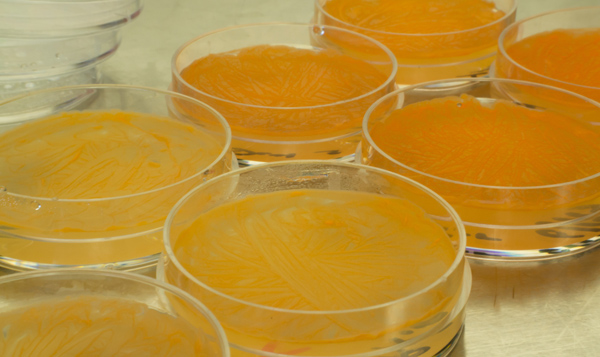
Researchers and graduate students began noticing another effect of these VOCs: fungus inhibition. The fruits exposed to the bacterium were not getting moldy.
Chris Cornelison was at the time a graduate student at Georgia State. He had been seeing the photos of dead bats piling up in caves, and a thought crossed his mind.
“I was standing there looking at a bucket of moldy bananas next to a bucket of bananas with no mold,” says Cornelison. “If the bacterium could be so effective on fungi on bananas, could it have similar effects on fungus on bats? It was one of those leaps of thought in science that maybe only a grad student could make.”
Cornelison, now a post-doctoral research associate at Georgia State, exposed petri dishes of the fungus that causes WNS (Pseudogymnoascus destructans) to the bacterium.
“The first exposure seemed too good to be true,” says Cornelison. “I had to test it five more times before I believed the results. It had dramatic effects on the fungus. It seemed like this could be a big step in managing white-nose syndrome.”
A Cooler Full of Bats
Other bat researchers and conservationists saw the potential for this bacterium and the potential to take action against a conservation issue that was frustratingly difficult to combat.
“When white-nose syndrome was first documented, we were scrambling to find information,” says Katie Gillies, director of the imperiled species program at Bat Conservation International (BCI). “We had to research the disease, understand how it works, how it spreads. But we also knew we had to take action.”
A number of partner organizations – including BCI, The Nature Conservancy and the U.S. Forest Service – worked with Georgia State researchers to test this bacterium as an initial tool to help manage WNS.
“In 2012, we tried our first crazy idea to build an artificial bat cave that could help us provide a hibernating place for bats that we could clean every year,” says Gina Hancock, state director for The Nature Conservancy in Tennessee. “Then when we formed a partnership with BCI, we kicked around what was the most promising work being done, and biocontrols came to the top of the list.”
Hancock notes that there was no public money being spent on this kind of research, so The Nature Conservancy and BCI sought proposals to accelerate the research.
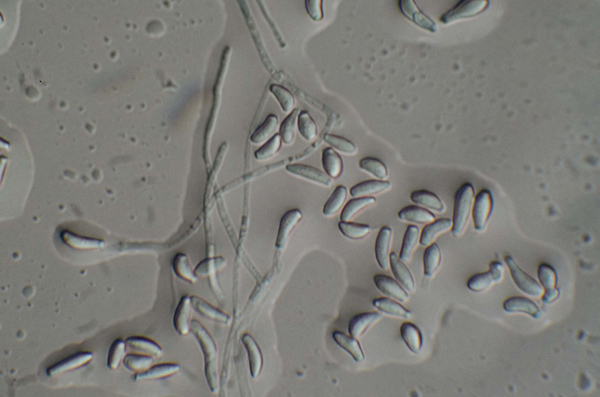
At Georgia State, the laboratory results continued to be impressive. The next step was to test the bacterium on bats in a laboratory setting, and it worked. Bats suffering from WNS recovered.
Of course, the bacterium is essentially a biocontrol – a biological method of controlling an invasive species. As Cornelison notes, the use of biocontrol has a checkered history, one filled with unintended consequences.
The impacts of the bacterium on other native organisms would have to be fully vetted. But in the meantime, bats could be treated in a limited field setting.
First, bats suffering from various levels of WNS were collected in the wild. They are not actually treated with the bacterium; it’s the VOCs that have the anti-fungal properties.
The bats were placed in a mesh bags, then put in a large Yeti cooler containing plates of the bacterium. They stay there for 24 to 48 hours.
The treated bats were then placed in an enclosure in a wild cave, where they spent their hibernation. This spring, they were collected and tested for presence of WNS.
“We tested for their fungal load and compared that to the fungal load when we first captured them,” says plant pathologist Daniel Lindner, of the U.S. Forest Service’s Center for Forest Mycology Research. “The bats had no detectable signs of white-nose syndrome and could be released.”
Some of the bats had such severe wing damage from the fungus that they could not be released (these animals will serve as conservation ambassadors), but 75 were released at the Mark Twain Cave Complex in Hannibal, Missouri.
The bacterium does not cure WNS; it arrests the development of the fungus and inhibits its growth. But it is still a tremendous first step in finding ways to manage the disease.
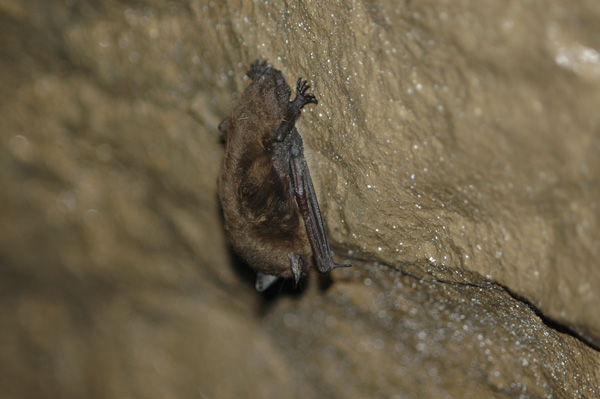
From Lab to Cave
Could this bacterium be used to treat caves? Yes, but first more tests are needed. The treatment has to be tested for potential toxicity to other cave organisms, including native fungi. (This is why fungicides have not been used to fight WNS; they typically kill all fungi, not just the harmful species).
“We have to make sure it’s not going to upset the cave’s delicate ecology,” says Lindner.
Once those tests are completed, how do conservationists actually treat a wild cave? Researchers are considered a nebulizer that pumps the VOCs into the cave. “It’s a very sophisticated version of a commercial grade air freshener, like what a hotel might use,” says Lindner.
It could lead to treatment of caves, mines and bunkers – potentially creating safe havens for bats. “In this trial, we had to touch every single bat,” says Gillies. “The goal is to optimize this tool so that we can treat a large number of bats without touching them.”
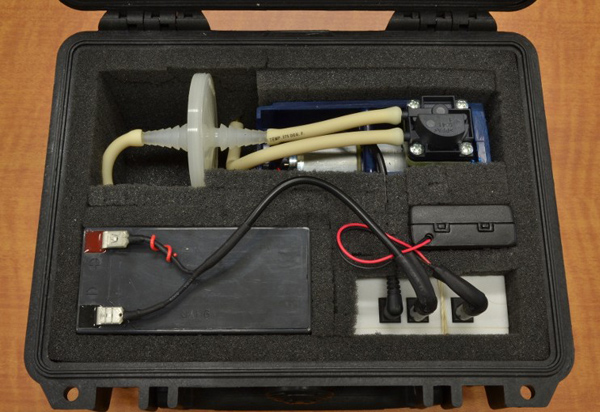
Even then, this tool will not eliminate WNS.
“This is one tool but we will need many more to manage this disease,” says Lindner. “But tools like this could help us manage the disease. It buys time for bats to adapt to the disease and develop resistance. That could prevent extinctions and allow healthy bat populations to rebound.”
For several years, talking to bat conservationists was an exercise in despair, in helplessness. WNS is still a major problem, and one that will continue to require innovation and research on a number of fronts.
But the sight of bats – bats that would have died of the disease – flying through the woods after successful treatment suggests a new chapter in this story. A new hope. “We are finally at the point where we can intervene on white-nose syndrome,” says Gillies. “It is not a silver bullet. We need more tools. But it is a first step. A huge first step.”
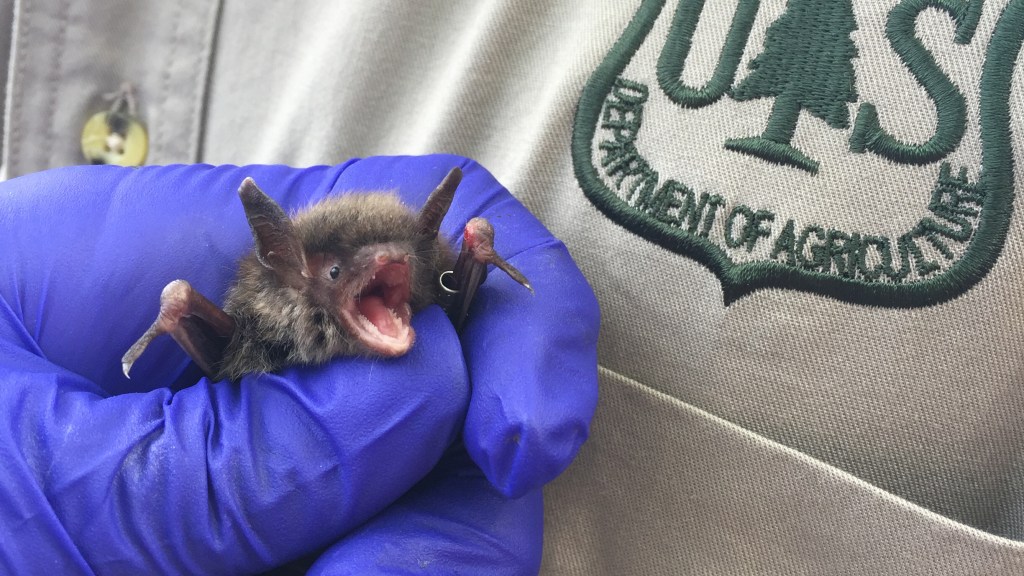



have missed seeing bats flying at dusk in my neighborhood this summer-wonder if WNS is partly to blame?
As someone who suffers from multiple negative effects from a variety of mold, including seizures, I hope and pray this is successful. Keep up the good work!
Many comments made by readers brought up good points that the researchers may not have been aware of.
Sharing our thoughts and comments, just like the observations that Georgia State student Chris Cornelison made and decided to test his thoughts to see if there was any change.
Sharing and communication resolve many things.
The Bats thank you….and I do too!!!!! Keep up the good work, bats play a very important role in our eco-system.
If the VOCs are found to be fairly targeted on the white nose fungus, then natural biological vectors for bringing it to the bats, or bio-engineering bat fur bacteria to produce these VOCs might be considered.
Testing the spectrum of fungal toxicity: is anyone checking bat caves in the vicinity of banana plantations, to see if the bacterium or related sp. with similar VOC emissions are present? Just a thought.
Constantly spraying all bat caves is unrealistic and spraying selected ones is a limited short-term solution.
I have a sneaking suspicion that all the ‘bio engineering’ that groups like Monsanto are doing are the reason this occurred in the first place. Perhaps less interfering in this way would go further. The paranoia in me is saying that first they have attacked our bees and created ‘new and improved’ bees, and now they are attacking our bats. Anything to gain complete control of the agriculture of the world.
When is this going to be published in a peer-reviewed journal?
Can small fungi-seeded “packets” be sold alongside bat houses? Wet, and attach inside the bat house? We have bat houses outside our own home and the ability to stop WNS in bats using those as roosts would be wonderful!
Dried-out rubbery, impregnated agar in a mesh suet-type bag would be easy to soak in water for a few hours, then tack inside the bottom of a bat house.
One person mentioned the possible re-infection. But with the bats that had WNS, they survived with the help of the VOC’s, and are healthy now, might they have gotten a vaccine-like effect, and be immune to re-infection?
Is there any research in seeing if these VOC’s could be used against black mold in homes. Thousands of houses are torn down because black mold is so aggressive. Someday, may we see homes pumped full of VOC’s becoming mold-free?
Is there any chance that the bats could eat the VOC’s and like plants that absorb pesticides, they would be protected?
Great news, I’ve been very concerned about this issue, and I’m really glad to hear there is a possible treatment. Godspeed.
Keep up the good work. More research is needed to possibly control the fungus responsible to prevent recontamination or I fear your efforts would be akin to relieving oneself into the wind.
Love your observations and successful use of the fungi to help the WNS of our bat population. I had bats stop at the under hanging of our home in White Lake MI.The neighbor and I encouraged them to roost their. At first I thought they were hummingbirds. About same size and fast flight patterns.The neighbor liked our bats so much he put up a bat house. We need people like you to continue with your work.
Speaking of compounds to nebulize: Has anyone tried Grapefruit Seed Extract (GSE), produced by Nutribiotic and other companies. It is fungicidal, bactericidal and viricidal at low concentrations, and is an organic product.
Hi Carolyn,
I will let the researchers comment on the use of GSE in controlling white-nose syndrome. However, I will note that I have seen it used in wader cleaning stations along trout streams to stop the spread of invasive species like New Zealand mud snails, and it appears to be effective.
This may be way off, but I treated my thrush (a yeast/fungus) with acidophilus tablets. Is there a possibility of providing the bats with a food or water source treated with acidophilus, until the fungus no longer has a source. I was able to ween off of it eventually. I just wondered if this route of treatment, as the other lady said, is more natural and perhaps more sustainable. Certainly, it would cause less impact on surrounding ecosystems.
Is it possible that bats treated in this way can pass their newfound ability to deal with the syndrome onto their offspring?
No. In order for it to pass on anything to its offspring the characteristic must be genetic. It can’t pass things like this on unless it was a part of Its DNA.
I am elated over this news for bats. And while I realize the war is not over I can see the hope this brings. Congratulations!
Once the bats are released they will be subject to re-infection if they go back to an infected cave so this is indeed a bandaid on a cancer. It is great news but if there were a way to treat the bats and then keep them quarantined until a safe haven can be established for them wouldn’t that better? It is a very circular problem is it not? The issue of the Voc killing off other good fungi is like our problem with antibiotics and the biota in our guts. However we have developed ways to counteract these effects to some degree. We might have to preserve populations of the good fungi to reintroduce them after the “sick” caves are disinfected so to speak. What think you?
Exactly. What happened to their protective cave fungi that would have prevented the p. destructans from proliferating in the first place? The natural cave flora must be rebuilt.